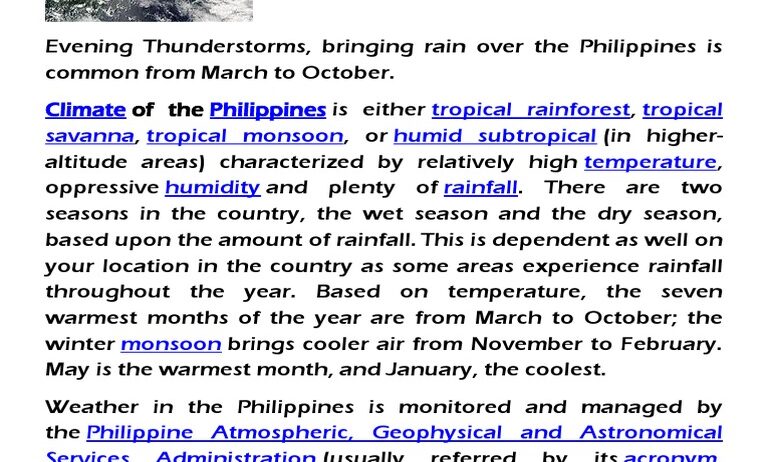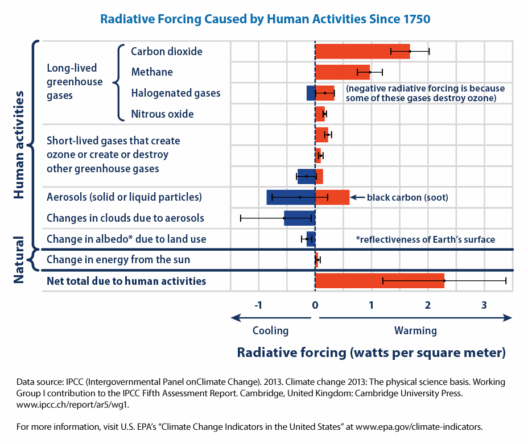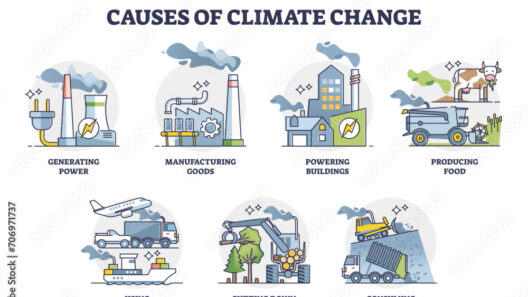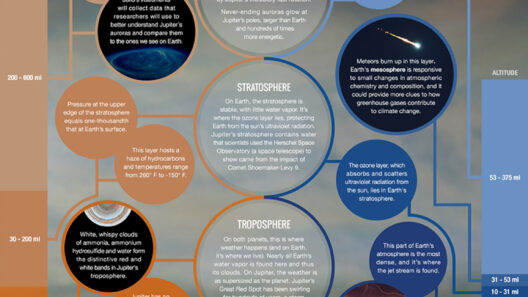The Philippines, an archipelago of over 7,000 islands nestled in the heart of Southeast Asia, showcases a climate as diverse and dynamic as its rich culture and biodiversity. Defined predominantly by its tropical monsoon climate, the archipelago serves as a stage where the elements of heat and water dance in a poetically chaotic rhythm. This climatic tapestry comprises two distinct seasons—wet and dry—each painting a unique portrait of the islands’ atmospheric conditions.
To understand the essence of Philippine climate, one must first immerse themselves in its warmth. The dry season, stretching from November through April, brings with it a surge of sunshine that casts a golden hue across the land. Termed the “cool, dry season,” this period invites both locals and tourists to explore the verdant landscapes framed by cerulean skies. The heat can often be likened to a soft embrace, yet it possesses the latent intensity of a simmering kettle, ready to erupt into an unexpected deluge.
It is during the dry months that the islands bask in the fervor of prolonged sunshine, where average temperatures hover between 25 to 35 degrees Celsius (77 to 95 degrees Fahrenheit). As the sun ascends in the eastern horizon, it ignites the very air with warmth that wraps itself around every inhabitant and creature. The beaches shimmer with the playful glints of sunlight, while bustling markets vibrate with activity, reflecting the vitality that this robust climate breathes into daily life.
However, as the calendar gracefully transitions into May and beyond, the atmosphere begins to sway, pregnant with anticipation for the onset of the wet season. This transformation is akin to an artist preparing their canvas—saturated colors are gradually introduced, offering a dramatic shift that sets the stage for the majestic and tempestuous nature of the Philippine climate.
The wet season, occurring from June to October, brings with it the cacophony of rain, thunder, and the visceral beauty of raging storms. Each year, the Philippine archipelago becomes the focal point for tropical cyclones, also known colloquially as typhoons. These mighty systems, born from oceanic warmth, are the harbingers of both destruction and renewal. Cyclones sweep through the islands like a tumultuous symphony, weaving torrents of rain that saturate the verdant soils, then retreating just as dramatically, leaving behind refreshed rivers and rejuvenated flora.
The Philippines is struck by approximately 20 typhoons annually, creating an intricate balance between nature’s fury and its regenerative powers. These storms, with their formidable winds often exceeding 200 kilometers per hour (124 miles per hour), not only test the mettle of communities but also provoke resilience among the populace. For the inhabitants of the islands, the seasonal arrival of typhoons embodies a duality; they bring both trepidation and a profound respect for the forces of nature.
Yet, one must reflect on the significance of the irregularities and escalating intensity of these storms, symptoms of the broader climate crisis afflicting our planet. There is an evolving narrative woven into the climate of the Philippines, one that speaks of poignant challenges precipitated by climate change. Rising sea levels, increasing sea temperatures, and altering rainfall patterns have imprinted their mark on this tropical haven. The unique biosphere, teeming with endemic species, hangs in the balance, vulnerable to these compounded stresses.
The duality of the Philippine climate echoes through its ecosystems. The verdant mountains, laced with dense forests and mist-laden peaks, absorb the rainfall, only to become reservoirs that feed rivers, lakes, and ultimately, the verdant rice paddies that cultivate life. Coral reefs, vibrant undersea kingdoms, teem with biodiversity, yet they too are imperiled by warming waters and ocean acidification, a tragic irony as these marine oases strive to thrive amid increasing adversity.
It is essential to understand how locals have developed a profound relationship with their climate, adapting their lifestyles and economies to intertwine with the rhythms of nature. Traditional agricultural practices, steeped in generations of wisdom, echo the evolving climate narrative. Farmers plant drought-resistant crops during the drier months, while they also prepare for the bounty that storms can sometimes bring—tempered by the risk of devastation. Fishermen adjust their practices to align with shifting fish migration patterns, navigating unpredictable waters as they have for centuries.
The climate of the Philippines is a testament to the beauty and brutality of nature, an eternal dance of tempest and tranquility. The islands reveal themselves as a complex mosaic where island heat and typhoon skies play their parts in creating one of the most biodiverse ecosystems on Earth. As the world grapples with the impacts of climate change, the Philippines stands as a poignant reminder of both the vulnerability and resilience that exists within ecosystems, communities, and the human spirit.
Ultimately, the climate of the Philippines serves as a living metaphor for life’s unpredictability—a tapestry woven with threads of sun-drenched warmth, torrential rains, and the indomitable spirit of those who call these islands home. As global stewards of this planet, the responsibility remains to protect such vibrant ecosystems, ensuring that they continue to thrive amidst the challenges ahead. The beauty of the Philippine climate must not be just a fleeting moment of ecstasy, but a lasting legacy for generations to cherish and protect.








